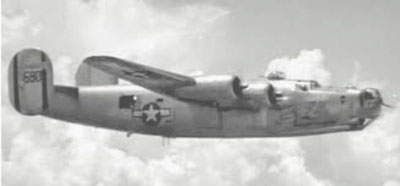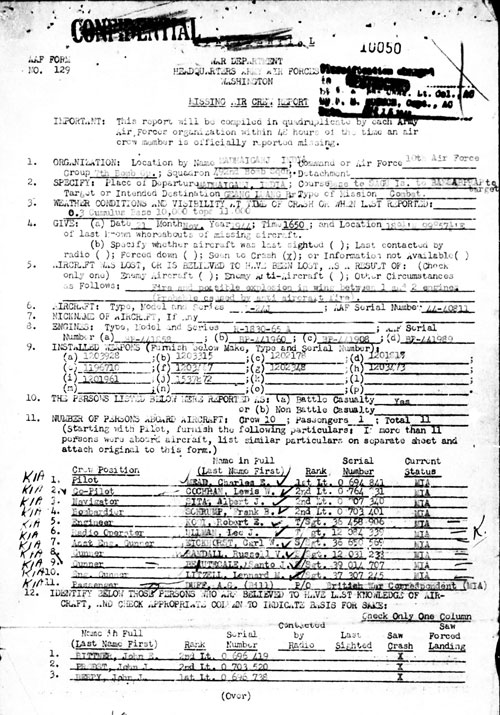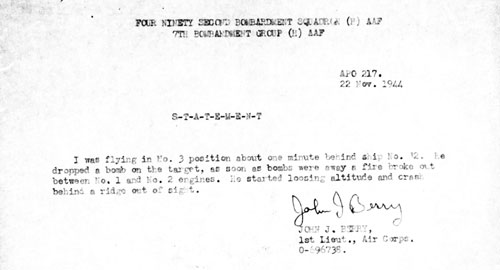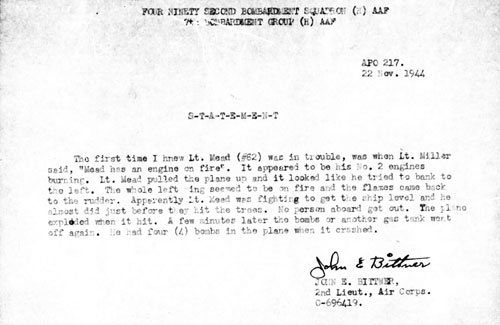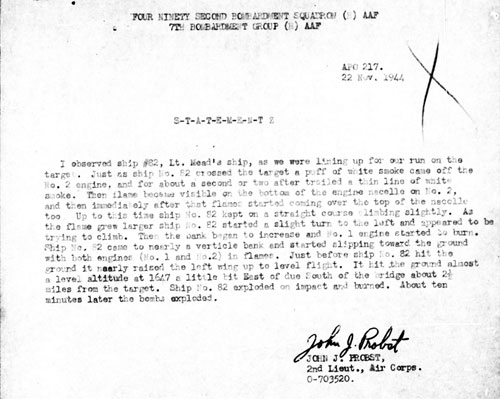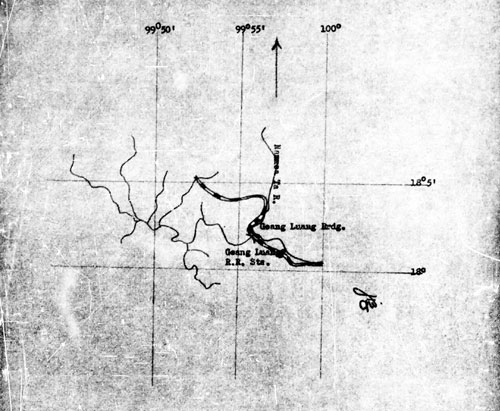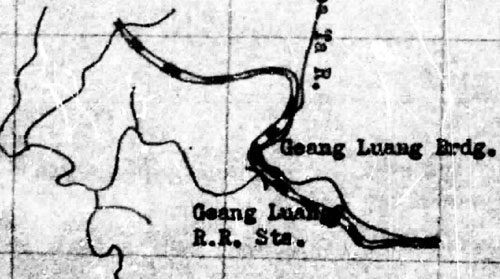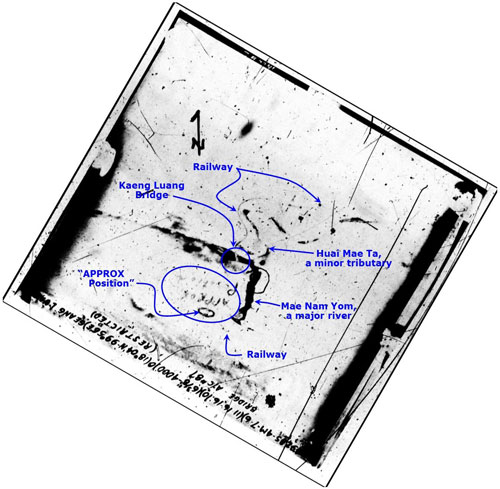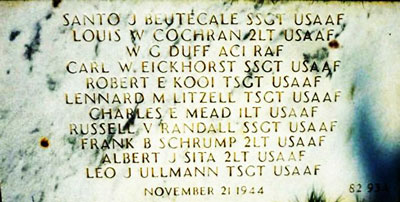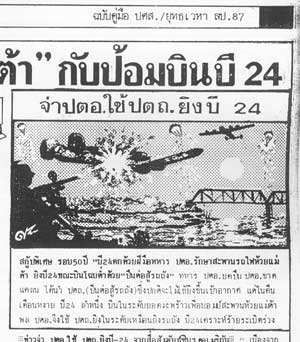| Details of Aircraft Losses by Date |
| Text | Notes | |||||||||||||||||||||||||||||||||||||||||||||||||||||||||||||||||||||||||||
|
21 Nov 1944: on this date, an Allied B-24J heavy bomber was shot down while attacking the Kaeng Luang Railway Bridge over the Yom River in Phrae Province located between Lampang and Uttaradit in northern Thailand.[1]
The plane, one of twelve in this mission by the 492nd Bomb Squadron homebased in Madhaiganj Army Air Base, India, passed over Sagu Island, Burma; then Sop Prap, Thailand; to arrive finally at Kaeng Luang:[2]
The bridge was targeted as part of a strategy to stop supplies destined for the IJA in Burma which were moving by rail from Bangkok to Lampang where they were then transferred to trucks for traveling north on the Phahonyathin Road to Mae Sai and on into Burma. There were two major railway bridges on that route: one of 263 m at Ban Dara and a 174 m bridge at Kuang Luang.[3] Both were under regular attack in an era when "pin point" bombing accuracy did not exist; in an attempt to compensate for that inaacuracy, bombers were dropping to 300 feet (100 m) altitude to deliver bomb loads and still having difficulty knocking out targets --- not only bridges, but also railway stations, marshalling yards, tunnels, etc. But aircraft at that low altitude were extremely vulnerable to enemy ground fire and that's what brought down Mead's B-24. Missing Air Crew Report (MACR) 10050 recorded the details:[4]
Key information:
Witness statements: • Statement by John J Berry, 1st Lt:
A careful examination of the details might find the content foreshortened roughly north to south, indicating the photo to be an obligue view and resulting in this interpretation:[6]
The "APPROX Position" is the location of the crash. Coordinates for that position in the photo are about N18°01.9 E99°55.3. The location specified in the MACR text is N18°00.25 E99°57.50, about 5.5 km away to the SE. The statement by Probst places the crash site just east of about 2½ miles south of the target. This would probably be the most useful in locating the crash site today in that the position coordinates in the MACR use a datum differing from the currently used WGS84; and the poor quality of the aerial photo makes any interpretation questionable. As emphasized with capital letters in the photo, the position is approximate. In either case, the locations imply the attack came in from the north of the bridge. After the war, with this information and probably local assistance, an American Graves Registration Service team was successful in locating the remains of the crew and its passenger. They were interred in a collective grave at Jefferson Barracks National Cemetery, Lemay, St. Louis County, Missouri, USA, per this memorial plaque:[7]
Translation:[10]
Comment: Note that the shooter is not identified by name.
|
These pages were composed to be viewed best with Google Chrome. This webpage expands on Kaeng Luang Bridge, Phrae Province, elsewhere on this website. 1.^ Railway stationing for bridge: 546+94 (BR Whyte, The Railway Atlas of Thailand, Laos and Cambodia (Bangkok: White Lotus, 2010), p 28) Photo: Pacific Wrecks, B-24J-175 "Lonesome Lady" 2.^ "Terrain" map from Nations Online Project: Searchable Map and Satellite View of Thailand using Google Earth Data. Annotations by author using Microsoft Publisher. The flight plan is set out in the Missing Air Crew Report (MACR) 10050, copied here. Madhaiganj Airfield: Sagu Island is identified under "Course" in the MACR (p 1). "BanSabprap" in USAAF context probably refers to a peak in the prominent mountain ridge (53 air-km SSW of Lampang) directly west of modern day (Ban) Sop Prap, which is located in the Wang River valley about 40 air-km downstream of Lampang. 3.^ Railway bridge data from BR Whyte, ibid, pp 27 4.^ MACR 10050 provided by Mike Stowe, email of 20:41 30 Nov 2012, accireport@comcast.net
4a.^ Name correction per Jefferson Barracks National Cemetery Memorials. Function from MACR, Item 11.
f
5.^ The map is an extract from Google Maps, annotated by author using Microsoft Publisher.
6.^MACR page 9 annotated by author using Microsoft Publisher.
7.^ Jefferson Barracks National Cemetery Memorials.
8.^ Photo of crew from 7thBGHF. Downloaded 13 Dec 2012. Link no longer active. Crew names were captioned with the proviso "order unknown".
9.^ รัตนชัย, สักดิ์, ปาะวัติศาสต์ศึกษายุทธเวหาลำปาง [Rattanachai, Saksern S, Japan in Lampang during World War II (Lampang: (self-published), undated)] Ch 70, p 114. In an alternate account, Young, Edward M, in B-24 Liberator Units of the CBI (Oxford: Osprey Combat Aircraft-87, 2011), p 37, states that Japanese machine gunners brought down Mead's plane. Source: Google preview., accessed 2014: URL link no longer functional. While the use of an anti-tank gun for anti-aircraft duty seems innovative, note that the IJA Model 98 20mm (p 217), the Model 96 Type 2 25mm (p 230), and the 40mm single and dual mounted (p 230) automatic cannons were all titled "antiaircraft antitank", per Chapter 9, TM-E 30-480 Handbook on Japanese Military Forces (Washington: War Department, 1944). With regard to moon light, the plane was shot down at about 1645 and the sun was still well above the horizon. The remoteness of the Kaeng Luang Bridge for its defenders is captured on Rotfaithai.com, particularly photo. The bridge is better known locally as Huai Mae Ta Bridge since it spans the Huai Mae Ta and the closest station carries the same name, at railway stationing 546+94 (per Wisarut Bholsithi email of 12:50 29 Apr 2013). 10.^ Translation by Chanagun Chitmanat, 2008. 11.^ 梅本弘 [Umemoto, Hiroshi], ビルマ航空戦・上 12.^ Umemoto, ibid, pp 327-328. 13.^ Japanese translations by Google Translate; edited by author.
|
|||||||||||||||||||||||||||||||||||||||||||||||||||||||||||||||||||||||||||
